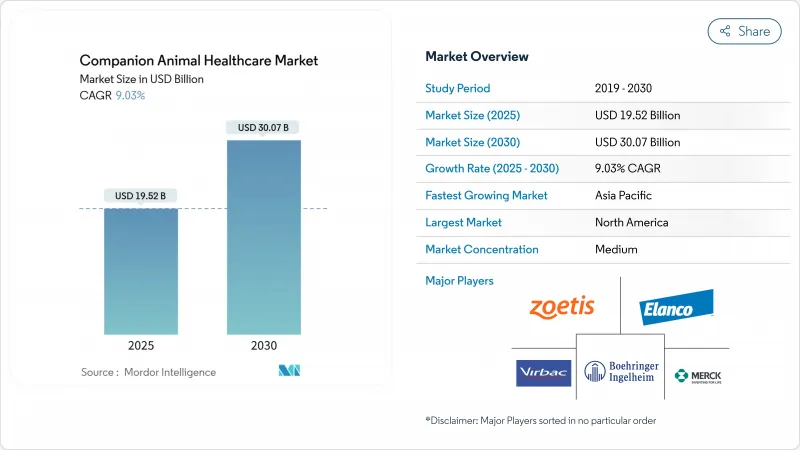
|
市場調査レポート
商品コード
1851979
コンパニオンアニマルヘルスケア:市場シェア分析、産業動向、統計、成長予測(2025年~2030年)Companion Animal Healthcare - Market Share Analysis, Industry Trends & Statistics, Growth Forecasts (2025 - 2030) |
||||||
カスタマイズ可能
適宜更新あり
|
|||||||
| コンパニオンアニマルヘルスケア:市場シェア分析、産業動向、統計、成長予測(2025年~2030年) |
|
出版日: 2025年08月25日
発行: Mordor Intelligence
ページ情報: 英文 114 Pages
納期: 2~3営業日
|
概要
コンパニオンアニマルヘルスケア市場規模は2025年に195億2,000万米ドルに達し、CAGR 9.03%を反映して2030年には300億7,000万米ドルに拡大すると予測されています。

ペットの人間化の進展、AI対応診断の着実な展開、定額制ウェルネス・プランの普及により、獣医サービスの需要とアクセスの両方が拡大しています。画期的なモノクローナル抗体は治療薬のポートフォリオを強化し、POC(ポイント・オブ・ケア)分析装置は診断の所要時間を短縮し、臨床上の意思決定を改善します。デジタル・コマース・チャネルは拡大を続けており、遠隔診察、薬局業務、宅配を連携させることで、従来の診療所モデルを補完しています。地理的には、北米が最大の収益源を維持しているが、都市化と可処分所得の上昇に伴い、アジア太平洋地域が最も急成長しています。
世界のコンパニオンアニマルヘルスケア市場動向と洞察
ペット飼育の増加と動物の「人間化
ペットの人間化によって支出の優先順位が変化し、飼い主の66%が延命治療薬を検討する意向を示し、2024年には毎月の支出額の中央値が260米ドルに上昇。中国の調査によると、飼い主の55%がペットを子供とみなしており、プレミアム・ケアの購入に拍車をかけています。ウェルネス予算は、QOL(生活の質)を向上させる薬、高度な画像診断、オーダーメイドの栄養補給をますます好むようになっています。保険加入率はこの変化を反映しており、犬を飼っている人の45%、猫を飼っている人の36%が保険に加入しており、家計計画に動物医療が組み込まれています。
ペット保険の普及拡大
保険料は2024年に45億米ドルに達し、2019年の水準の2倍以上になります。上位10社の保険会社が市場の90%を支配し、商品設計と引受効率が研ぎ澄まされています。2024年のNAICペット保険モデル法によって規制が明確化され、予防的ウェルネス・アドオンと真のリスク移転商品が分離されました。しかし、医療のインフレにより、Nationwide社は10万件の契約から撤退することになり、Petco社やNationwide社などの販売提携が規模の優位性を追求する中でも、コスト抑制の圧力があることを物語っています。
高騰する獣医療サービスと薬剤費
医療費は2014年以降60%上昇し、全体的なインフレ率を上回っています。マース・ベテリナリー・ヘルスは企業経営のクリニックの半分近くを支配しています。請求額の上昇により、2024年の来院数は2.3%減少し、検診間隔は48%長くなりました。また、国防総省は現在、軍用家族にペットの移転費用として2,000米ドルを払い戻ししており、部分的に経済的な障壁を緩和しています。
セグメント分析
治療薬セグメントは、ワクチン、寄生虫駆除薬、モノクローナル抗体の急速な普及に支えられ、2024年のコンパニオンアニマルヘルスケア市場の42.78%を占めました。Bedinvetmabの業績により、ゾエティスは2024年第3四半期にコンパニオン・ポートフォリオを18%押し上げました。寄生虫駆除剤の売上は小売チャネルに流出しているが、予防ワクチンは不可欠な役割を維持しています。抗感染症薬はジェネリック医薬品の競合により成長が抑制され、抗菌薬耐性により規制当局の監視は厳しさを増しています。
診断薬は2030年までのCAGRが最速の12.58%を記録し、精密医療への構造変化を示します。AI対応分析装置は血液学、尿検査、画像診断を統合プラットフォームに統合し、診断所要時間を数日から数分に短縮します。POC機器を使用するクリニックでは、顧客のアドヒアランスが向上し、収益の増加が報告されています。機械学習が解釈のばらつきを削減し、エビデンスに基づくケアモデルを推進するため、診断のコンパニオンアニマルヘルスケア市場規模は大幅に拡大すると予測されます。
地域分析
北米は、成熟した保険の普及、高度な診療インフラ、バンフィールドの予防プランのようなロイヤルティプログラムが持続的な支出を支えるため、2024年の世界売上高の42.32%を創出しました。ChubbがHealthy Pawsと86億米ドルを投じて複数のクリニックを統合し、750の拠点を持つネットワークを形成したことで、統合は状況を一変させました。2030年までに7,500万頭のペットが医療を受けられなくなるとの予測もあり、規制当局がインセンティブを後押ししています。
アジア太平洋地域がCAGR10.31%で最も急成長しており、これは都市部の中流家庭の増加が拍車をかけています。中国のペットヘルスケア部門は、2015年以来17.7%の複合成長で2022年には1兆620億元に達するが、診療所の密度は米国に遅れをとっています。韓国では、ライフスタイル調査によると、若い成人は子供よりもペットを好み、裁量資金をプレミアム・ケアに回しています。オーストラリアは成熟したサブマーケットであり、ゾエティスの2023年売上高4億8,400万米ドルとメルボルン製造拠点買収は、この地域の長期的な定着を示しています。
欧州は、獣医学カリキュラムの充実と薬事規制の調和に支えられ、着実な拡大を記録しています。ベジンベトマブがフランス、ドイツ、イタリア、スペイン、英国で同時に展開されたことは、先進的生物製剤に対する意欲を裏付けるものです。持続可能性の要請は治療の選択に影響を及ぼし、二酸化炭素排出量を削減し、動物福祉に配慮した製品が支持されています。EQTがVetPartnersを買収して267のクリニックをネットワークに加え、この大陸の統合サービスに対する意欲を示すように、国境を越えた投資は依然として活発です。
その他の特典:
- エクセル形式の市場予測(ME)シート
- 3ヶ月のアナリストサポート
よくあるご質問
目次
第1章 イントロダクション
- 調査の前提条件と市場の定義
- 調査範囲
第2章 調査手法
第3章 エグゼクティブサマリー
第4章 市場情勢
- 市場概要
- 市場促進要因
- ペット飼育の増加と動物の人間化
- ペット保険の普及拡大
- 先進的な臨床内・POC診断の急速な普及
- OA・皮膚科向け慢性期治療用モノクローナル抗体(Mabs)ブーム
- 微生物ベースの治療薬の商業化
- 動物病院チェーンによる定額制ウェルネス・プラン
- 市場抑制要因
- 高騰する獣医療サービスと薬剤費
- 偽造・グレーマーケット医薬品の拡散
- 熟練獣医師と獣医技術者の世界的不足
- 遺伝子編集・細胞治療製品に対する規制の遅れ
- 規制情勢
- ポーターのファイブフォース
- 新規参入業者の脅威
- 買い手の交渉力
- 供給企業の交渉力
- 代替品の脅威
- 競争企業間の敵対関係
第5章 市場規模と成長予測
- 製品タイプ別
- 治療薬
- ワクチン
- 寄生虫駆除剤
- 抗感染症薬
- 非ステロイド性抗炎症薬と疼痛管理
- モノクローナル抗体
- 医療用飼料添加物
- その他の治療薬
- 診断
- 免疫診断検査
- 分子診断学
- 画像診断
- ポイントオブケア検査機器
- その他の診断薬
- デジタルヘルス&サービス
- 遠隔医療プラットフォーム
- 診療管理ソフトウェア
- ウェアラブル・モニタリング・デバイス
- 治療薬
- 動物のタイプ別
- 犬
- 猫
- その他の動物の種類
- 流通チャネル別
- 動物病院&クリニック
- 小売薬局
- オンライン/eコマース・プラットフォーム
- 地理
- 北米
- 米国
- カナダ
- メキシコ
- 欧州
- ドイツ
- 英国
- フランス
- イタリア
- スペイン
- その他欧州地域
- アジア太平洋地域
- 中国
- 日本
- インド
- オーストラリア
- 韓国
- その他アジア太平洋地域
- 中東・アフリカ
- GCC
- 南アフリカ
- その他中東・アフリカ
- 南米
- ブラジル
- アルゼンチン
- その他南米
- 北米
第6章 競合情勢
- 市場集中度
- 市場シェア分析
- 企業プロファイル
- Zoetis Inc.
- Boehringer Ingelheim Animal Health
- Elanco Animal Health
- IDEXX Laboratories Inc.
- Virbac
- Merck Animal Health(MSD)
- Ceva Sant Animale
- Phibro Animal Health Corp.
- Mars Veterinary Health(Banfield & VCA)
- Covetrus Inc.
- Heska Corp.
- Dechra Pharmaceuticals plc
- Vetoquinol SA
- Neogen Corp.
- Norbrook Laboratories
- KRKA d.d.
- Zomedica Corp.
- PetIQ Inc.

